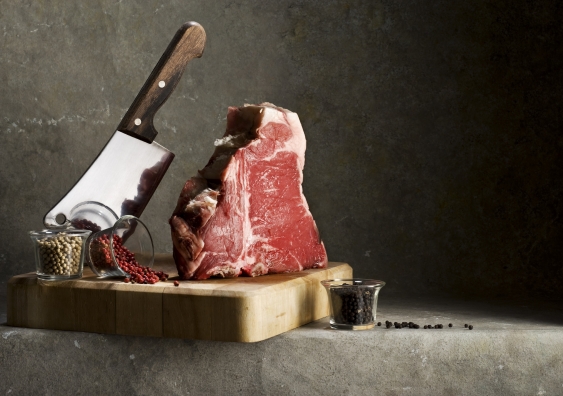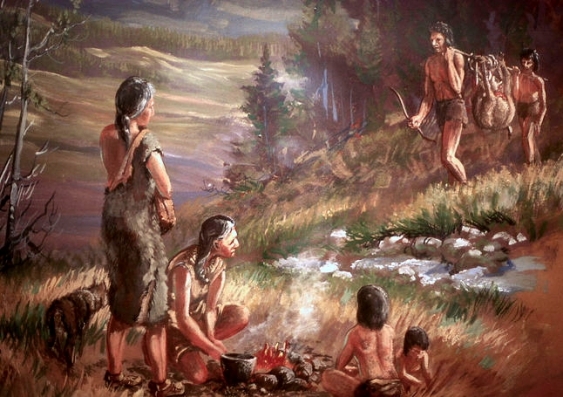Spare your health, budget, and the planet: ditch the paleodiet
A cursory look at the palaeodiet highlights a wilful ignorance of the science behind human evolution, writes Darren Curnoe.
A cursory look at the palaeodiet highlights a wilful ignorance of the science behind human evolution, writes Darren Curnoe.

OPINION: Interest in the diet of our evolutionary ancestors would ordinarily be a topic of curiosity in only the most obscure of scientific circles.
But the popularity of the so-called palaeodiet has brought unprecedented attention to the foods consumed by Stone Age or Palaeolithic people.
And, it might ultimately be doing us all more harm than good.
The palaeodiet is claimed to be a recipe for natural health and able to cure a vast range of diseases.
We await the clinical trials to pass verdict on its claimed disease-curing benefits, but at the moment most such claims seem like little more than snake oil peddling or faith healing.
Even a cursory look at the palaeodiet highlights huge contradictions and a wilful ignorance of the science behind human evolution and diet.
Proponents of the palaeodiet eschew all processed food, but are happy to suck on beverages like wine.
Don’t be fooled though, wine, like many other components of the human diet, is a processed food.
Wine-making involves turning a fruit into an alcoholic beverage through the mechanical breakdown or heating up of grapes, addition of sugar, acid, nutrients, yeast and other chemicals to promote fermentation, add flavor, remove sediment and preserve the wine.
And humans have been processing their food for tens of thousands perhaps millions of years, so its absurd to think you can exclude processed food altogether.

Artist’s reconstruction of a stereotypical Palaeolithic camp scene with staple red meat. Wikimedia Commons
The palaeodiet eliminates all grains, legumes and potatoes, yet there is plenty of evidence that humans have evolved to eat carbohydrates especially starches.
Take the amylase genes which evolved to aid the digestion of starch either in our saliva or pancreas through secretion into the small intestine.
Humans are unique among primates in possessing large numbers of salivary amylase genes and there is a clear association between gene number and the concentration of the amylase enzyme in the saliva.
Plant foods containing high quantities of starch may even have been essential for the evolution of the large human brain over the last 2 million years, according to new research by Karen Hardy from Universitat Autónoma de Barcelona and colleagues published recently in The Quarterly Review of Biology.
Our brains are three times the size of our chimpanzee cousins and are undoubtedly the seat of many of the differences between us in terms of our biology, including behaviour.
Previous models such as the ‘expensive tissue’ hypothesis of Aiello and Wheeler proposed that the use of stone tools facilitated a shift from a mostly plant-based to largely meat-comprising diet in our ancestors in order to feed our large brains.
This shift, they suggested, facilitated the evolution of our enlarged brain as well as smaller teeth and reduced gut adapted for eating meat.
Yet there have been lingering doubts, sometimes claimed refutations, of the links between human evolution and meat eating.
There is no clear association across mammals, including primates, between an enlarged brain and reduced gut size.
Instead, large brains seem to be found in mammals that are capable of storing large amounts of body fat to stave off starvation and also have efficient forms of locomotion like our human bipedalism.
The new model from Hardy and co-authors suggests that cooked starch greatly increased energy availability to energy expensive tissues like the brain, red blood cells, and also the developing fetus.
They also suggest that the number of copies of the salivary amylase gene may have enhanced the importance of starch in human evolution following the controlled use of fire and development of cooking.
But there are of course many sources of carbohydrates in the diet and research suggests that early humans may have eaten underground food items like roots, tubers and rhizomes, as well as seeds, certain fruits and bark which are all widely available and rich in starch.
Grains were also an important and highly effective source of carbohydrates in the Palaeolithic, despite what the palaeo diet states.
Grinding seeds to make flour and probably bread is known from at least 25,000 years ago in Europe, arguably much longer, and humans have been cooking for at least 400,000 years, but perhaps even 2 million years.
The truth is we have no idea how much meat was eaten in the Palaeolithic because so little of the plant food remains have preserved for us to study and to garner an accurate picture of the complete diet of our ancestors.
Mammal bones with signs of butchering or cooking are plentiful in the archaeological record, but bones always preserve as fossils much longer than plant remains, and so we have a highly skewed view of past diets.
We would also do well to keep in mind that the role and safe amounts of animal food in the contemporary human diet remain controversial in nutritional and medical science regardless of what we think our ancestors may have eaten.
Red meat in particular has been linked to a range of diseases like metabolic syndrome, a variety of cancers, atherosclerosis and Type 2 diabetes, so a degree of caution about safe levels of consumption seems wise.
If your aim is to lose weight, then the palaeodiet is by no means your only option.
Much clinical research has shown that the key to weight loss is reducing the total amount of calories consumed, regardless of whether its carbohydrates, protein or fat.
Watch what you eat, reduce your calories and lift your activity level, is a tried and true formula that works for most people.
Studies of hunter-gatherers during the last couple of hundred years have also shown they walked an awful lot: on average 360 km a year, but up to 3,600 km.
So, you might consider a palaeo-exercise regime combined with a scientifically based and balanced diet as a healthy starting point for weight loss and general good health, rather than the potentially dangerous palaeodiet.
Nutritionists also advise greatly reducing the amount of factory-made foods we consume because much of it lacks nutritional balance, and often has excessive calories and high sugar, salt or fat.
I guess this is one thing palaeodieters and nutritionists are close to agreement on, probably because it seems an awful lot like common sense.
While palaeodiet inventor Loren Cordain argues we should only be eating animals that have themselves eaten a ‘wild’ diet, Australian celebrity chef Pete Evans has extended it to consuming only organic food.
Adopting such an approach to food selection is impossible for most of the planet’s 7 billion inhabitants who couldn’t afford expensive organically grown food.
Evans wants the palaeodiet to be the new ‘normal’ for everyone, but to me, this smacks of Western middle class elitism and is simply out of touch with the realities faced by most people on the planet.
Anyway, most of the sources of animal food consumed by palaeodieters are from domesticated animals, which have been bred for flavour and meat quantity, and haven’t eaten a truly wild diet for thousands of years.
Eating a diet based on wild caught food would also be devastating for the planet.
The environment is becoming degraded and its natural resources depleted on a remarkable scale and pace, and a good deal of this is associated with agriculture and activities like fishing.
It’s estimated that each year tens, perhaps hundreds, of millions of sharks alone are harvested from the oceans and in many places fisheries are far from sustainable.
Similarly, if you’re concern is with animal welfare, then organic farming may not always be the best choice.
We need to get the balance right in our food choices between the broader effects of production on the environment, welfare of livestock and impacts on humankind more broadly.
The United Nations predicts there will be almost 10 billion people in the world by 2050.
This will lead to a dramatic need to increase food production to feed the extra people.
The scale of the challenge ahead was pithily described by Charles Godfray and co-authors in an article about the challenges of population growth and food security in Science magazine in 2010:
This challenge requires changes in the way food is produced, stored, processed, distributed, and accessed that are as radical as those that occurred during the 18th- and 19th-century Industrial and Agricultural Revolutions and the 20th-century Green Revolution. Increases in production will have an important part to play, but they will be constrained as never before by the finite resources provided by Earth’s lands, oceans, and atmosphere.
All of this within the context of the growing impact global climate change will have on food and water availability as well.
If we’re truly concerned about the fate of the planet and humankind, especially those of us in the West, we all need to be prepared to comprise our lifestyles including our diet and ditch luxuries like the palaeo diet.
Eating large amounts of meat, especially animals that have eaten a wild diet, is simply unrealistic, unsustainable and unreasonable if we want to do our bit for nature and the rest of humankind.
Darren Curnoe is a human evolution specialist & ARC Future Fellow at UNSW.
This opinion piece was first posted in The Conversation.